
OpenStack Load Balancer as a Service (LBaaS)
OpenStack’s Load Balancer as a Service (LBaaS) provides a scalable and highly available solution for distributing network traffic across cloud-based applications. Integrated directly into OpenStack’s networking component (Neutron), LBaaS enables tenants to create virtual load balancers that ensure no single server becomes a bottleneck or point of failure.
LBaaS is essential in modern cloud-native architectures because it empowers developers and operators to deliver applications that are resilient, fault-tolerant, and horizontally scalable. Whether serving web applications, APIs, or backend systems, LBaaS ensures that traffic is intelligently distributed among multiple instances to handle load spikes and server outages seamlessly
Key Features of LBaaS in OpenStack
- Multi-Tenant Isolation: Each project or tenant in OpenStack can create and manage its own load balancers with complete isolation and access control, thanks to integration with Keystone.
- Virtual IPs (VIPs): LBaaS assigns a virtual IP address on a Neutron network, acting as a stable entry point for distributed services.
- Flexible Protocol Support: Supports common protocols including HTTP, HTTPS, TCP, and UDP. Listeners can be configured per protocol and port, giving fine-grained control over traffic entry points.
- Load Balancing Algorithms: Choose from algorithms like Round Robin, Least Connections, or Source IP Hash to suit application-specific requirements.
- Health Monitoring: LBaaS can perform regular health checks on backend instances using protocols like HTTP, TCP, or ICMP. This ensures traffic is only routed to healthy targets.
- Layer 7 (L7) Policies: Advanced content-based routing enables traffic segmentation by URL path, hostname, or headers, useful for microservices and multi-tier apps.
- TLS Termination: Built-in SSL offloading allows encryption to be terminated at the load balancer layer, reducing the load on backend servers.
- High Availability (HA): Supports active/standby amphora instances for failover and ensures zero downtime even if the primary load balancer fails.
- Scalability: LBaaS dynamically provisions isolated amphora VMs (based on HAProxy) across compute nodes, avoiding single points of failure and supporting scale-out architecture.
- Provider Driver Flexibility: Octavia is the default backend, but OpenStack supports integration with third-party hardware and virtual appliances such as F5, A10 Networks, or Radware through provider drivers.
- API-Driven Architecture: Full integration with OpenStack APIs allows developers and automation tools (like Heat, Terraform, or Ansible) to programmatically manage load balancer lifecycle operations.
Why Octavia?
Octavia is the official reference implementation for LBaaS in OpenStack. It replaces the deprecated Neutron LBaaS service and offers:
- A scalable architecture using dedicated amphora VMs or containers.
- Advanced features like L7 policies, TLS offloading, and UDP support.
- Integration with core OpenStack services such as Nova, Neutron, Glance, and Barbican.
Octavia’s design ensures that each load balancer is an isolated and self-contained appliance. This design enables higher security, better fault tolerance, and improved performance under load.
Real-World Applications
- Cloud-native Web Services: Distribute traffic across stateless application servers for improved uptime and user experience.
- Kubernetes Integration: Integrates with Kuryr to expose Kubernetes Services of type LoadBalancer through OpenStack’s LBaaS.
- Multi-tier Architectures: Route different URL paths to different backend pools using L7 rules.
- Dev/Test Environments: Enables development teams to deploy their own internal LBs without administrator intervention.
- Hybrid Infrastructure: Bridge OpenStack virtual environments with traditional network appliances using LBaaS provider drivers.
Comparison: Octavia vs. Legacy and Third-Party Load Balancers
| Feature | Octavia (Current) | Neutron LBaaS (Legacy) | Third-Party Integrations |
|---|---|---|---|
| Architecture | Amphora VMs | Agent-based HAProxy | Vendor-specific backend engines |
| HA Support | Active/Standby | Limited | Depends on vendor |
| Advanced Protocols | L7, TLS, UDP | Basic HTTP/TCP | Varies |
| API Compatibility | LBaaS v2 | Deprecated | LBaaS v2 compatible |
| Scalability | High | Low | Depends on deployment |
OpenStack LBaaS with Octavia transforms how applications are delivered in private and public cloud environments. With built-in support for automation, high availability, and modern load balancing features, it empowers organizations to build and scale resilient, service-oriented infrastructures. Whether you’re running web apps, Kubernetes, or microservices, LBaaS ensures reliability and efficiency at every layer.
